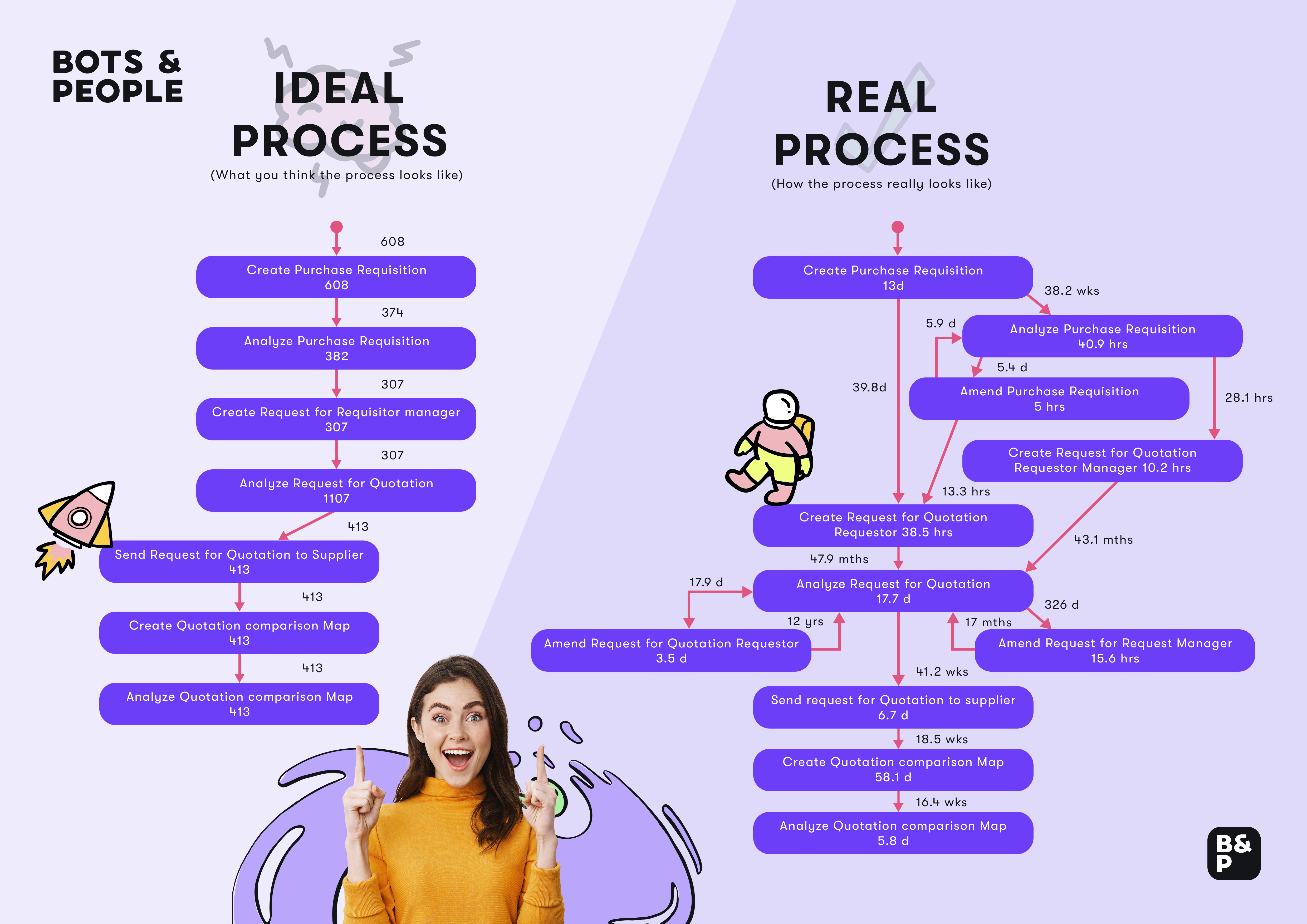More efficient, more cost-effective and more error-free: process automation brings numerous advantages. Employees can focus on important problems and challenges and no longer have to deal with tedious, monotonous routine tasks. But where to start in order to successfully automate business processes?
Process Automation Guide
The automation of processes, for example with Robotic Process Automation (RPA) or iPaaS solutions, was not only the talk of the town in 2020, but is still the talk of the town in 2021. Find out below which five steps you need to take to successfully automate processes in your company.
Info: To be able to apply this guide, it is recommended to build up internal competences. However, it is also possible to go through the steps with external experts. You can read about the advantages and disadvantages of this in the article "Make or Buy".
1. Analyze Business Processes with Process Mining
In order to be able to automate at all, it is first necessary to unlock the secrets of the existing processes and analyze the workflows in the company. Many processes are complex and opaque - products pass through numerous stations before reaching the sales department. Especially in larger companies, the various tasks, activities and data can quickly become confusing. Often it is not immediately obvious where things are going wrong. Process Mining helps to get an overview of where potential savings could be made. Possible software and providers should be carefully selected beforehand.
With this technology, any process can be quickly reconstructed, visualized and presented in a transparent way. In this way, it identifies inefficient processes and points out deficiencies in the business process. These can be, for example, invoices that deviate from the order or data that needs to be manually touched up.
Mining technology can be applied in all possible areas of companies. Thus, improvement potential becomes visible in accounting and Bookkeeping, Purchasing, Manufacturing, Controlling, Logistics, Human Resources or Sales. Not only the ideal process is analyzed, but also possible exceptions, errors and deviations that can happen. It thus serves as an ideal basis for RPA robots and the like, because it determines where automation is really worthwhile and where the pen needs to be applied in the company. Especially in the case of more complex workflows, automation should not be carried out mindlessly, but rather a sophisticated "battle plan" should be in place beforehand.

2. Prepare Processes for RPA and Co.
If processes are identified that often do not take place as planned, or are unnecessarily processed several times at different stations, these should be simplified even before the actual automation. Storing data in specific folders, customer contact or purchasing goods should be standardized so that as few variants as possible have to be automated. This makes automation more effective and easier to implement.
The keyword that should be at the beginning of any automation, whether RPA, iPaaS or API automation, is: standardization. It does not make sense if similar processes not only have different workflows across departments, but also across locations, and thus also require different automation solutions. Here, it also doesn't matter whether it's an RPA bot or an entire workflow automation in the cloud.
3. Select a Suitable Automation Method
Once the inefficient processes have been identified, process automation should be planned in a structured manner in order to assign the appropriate automation method to the processes. Here, it is important not only to consider individual sections of the tasks to be automated, but to develop an overall concept of automation and structures. The central questions: fundamentally change the IT or improve existing structures and which technology should be used for process automation. Does it have to be RPA or is it also possible via the interface or even with an iPaaS solution? Many laymen do not know that there is much more than the hyped robots and that RPA is only one of many possibilities.
In the case of a fundamental change of processes, Business Process Reengineering (BPR) is suitable from a methodological point of view. With BPR, the system is revolutionized from the ground up. We focus here on KVB measures, i.e. continuous improvements. Here, inefficient sub-processes are to be improved in small steps without changing the fundamental system. These subtasks can be automated using RPA or iPaaS. Since these are easy and inexpensive to implement, these technologies may even be worthwhile in some cases after a cost-benefit analysis when BPR solutions could improve the interfaces even further.
In order to determine the right sequence of automation, it is suitable to create a portfolio and prioritize it according to importance. An automation strategist, who deals with just such things, finally plans the approach and coordinates the cooperation of the various automation specialists. He knows whether automation is worthwhile, whether it has to be RPA or another technology, which software should be purchased and how implementation and monitoring have to proceed. This makes him perfectly suited for building and leading a Center of Excellence.
4. Implement Automation Slowly
In order to bring everyone along, it is important not to want to restructure the company from one day to the next and disrupt the activities of the employees. Automation itself is also a process: employees should be informed in good time and take part in professional training courses for RPA and the like. A suitable infrastructure must also be considered for comprehensively successful process automation in the company.
Because automation changes the way people work and the nature of their activities, many may be skeptical of the new technologies at first. Employees need to be shown opportunities that digitalization and automation can bring - such as the reduction of tedious routine tasks. At best, process automation should be introduced gradually so that everyone has time to get used to the new processes. Effective change management helps to establish process automation as a welcome digitization measure in the long term.
5. Monitor and Improve Partial Automation
Process mining can not only analyze classic business processes and digital activities, but also monitor partially automated processes to trigger further improvements. After automation software, such as RPA tools, has been introduced, it should be continuously checked whether it is running error-free and whether employees are interacting with the software robot without any problems. To make business processes even more efficient, the software can then be adapted and extended to other business areas if necessary.
Success Through Planning
Automation should be thoroughly thought through and planned in order to profit optimally from it. For this purpose, an Automation Strategist is suitable, who deals with all-encompassing analyses and planning. Together with a Process Mining Architect, the business processes must be analyzed in detail in order to automate the right processes. Furthermore, the RPA Developer should only implement process automations step by step and continuously improve them. This way, companies can remain competitive in the long run. After all, it's not just about getting software or a robot to run in an automated way, but also about moving forward in a holistic and planned manner.
You can see what success looks like in practice in our use case articles about procurement automation at SAP Ariba or the automation of Aumass eProcurement. Here, a combination of RPA and API automation was used.









